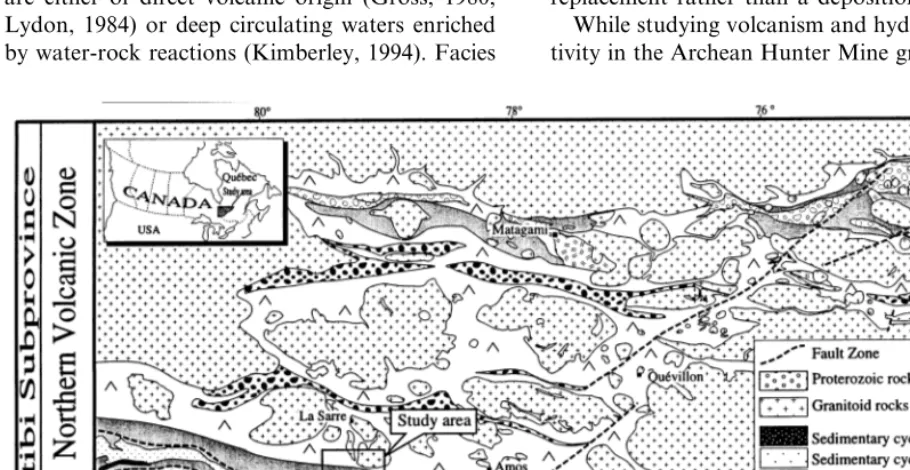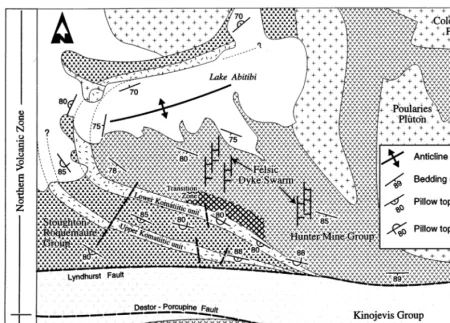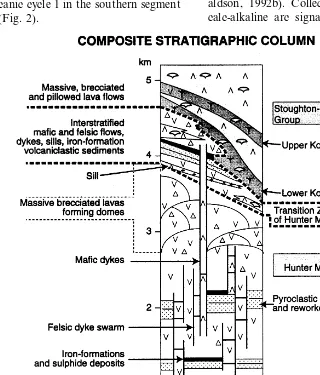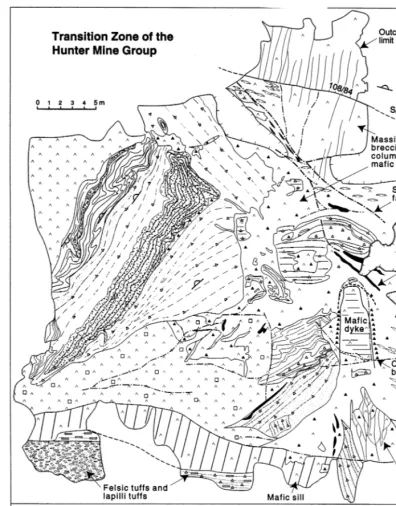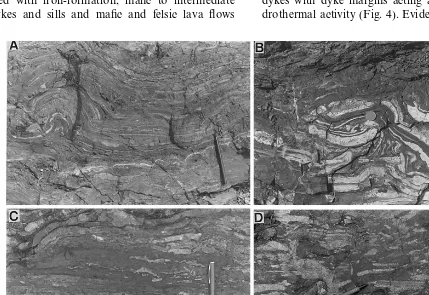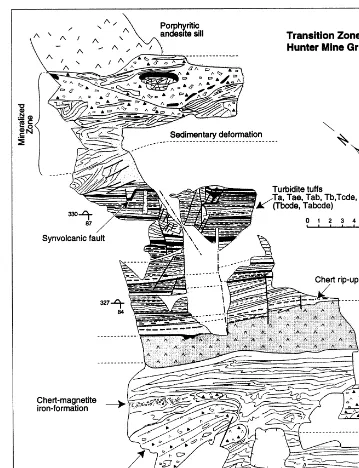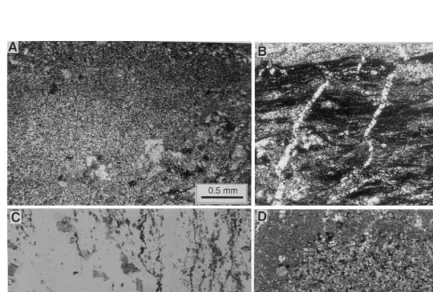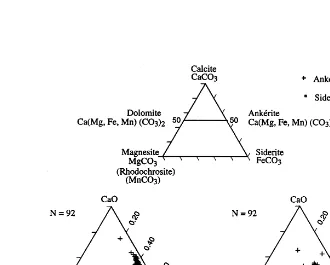Precambrian Research 101 (2000) 263 – 275
The relation between iron-formation and low temperature
hydrothermal alteration in an Archean volcanic environment
E.H. Chown *, E. N’dah, W.U. Mueller
Sciences de la Terre,Uni6ersite´ du Que´bec a` Chicoutimi,Chicoutimi,Que´bec,Canada G7H2B1
Abstract
The uppermost section of the Hunter Mine group (HMG) (2728 Ma), a bimodal volcanic complex in the Abitibi greenstone belt, contains both oxide and carbonate facies banded iron-formation (BIF). This paper explores the relationship between volcanic activity and the development of the two types of iron-formation. The oxide facies, represented by chert-jasper-magnetite iron-formation is widespread and recurs at several stratigraphic levels. Field evidence suggests it deposited directly on the sea floor during periods of volcanic quiescence, and is most probably derived from fluids seeping from volcaniclastic sediments and the compaction of felsic shard-rich tuffs. Seeping occurred along synsedimentary and synvolcanic faults and then along bedding planes. Carbonate (siderite) facies iron-formation, in contrast, formed locally below a silica cap rock by in situ low-temperature hydrothermal replacement of chert-tuff beds and even of the oxide formation. Thus the two types of iron-formation, although spatially and stratigraphically juxtaposed, are not the result of the same process, and only the carbonate facies appears to be directly related to a low temperature hydrothermal volcanic process. The contrasting genesis of oxide and carbonate iron-formations indicates that current simplistic models relating banded iron-formation to volcanic massive sulphide deposits need to be re-evaluated. The notion that oxide iron-formation represents a distal manifestation of volcano-generated hydrothermal activity may be the exception and not the rule, because, as indicated by this study, BIF occurs in the central part of a volcanic edifice, rather than on the flanks. © 2000 Elsevier Science B.V. All rights reserved.
Keywords:Iron-formation; Oxide; Carbonate; Low temperature; Hydrothermal; Volcanic; Archean
www.elsevier.com/locate/precamres
1. Introduction
The origins of iron-formations remain contro-versial (Kimberley, 1979, 1989; Dimroth, 1986). Banded iron-formations (BIF), prominent during the Archean-Paleoproterozoic, have been used to
indicate reducing atmospheric conditions during Earth’s evolution (Holland, 1984). The most re-cent classifications of iron-formations, or chert-bearing ironstones, (Kimberley, 1979, 1989; Fyon et al., 1992) distinguish those of shallow- and deep-water settings (Simonson, 1985), as well as directly deposited and replacement types of iron-formations. In Archean volcanic arc settings Fyon et al. (1992) recognize a shallow-water type which may deposit on eroded volcanic edifices, and the
* Corresponding author. Present address: 90 Dickens Drive, Kingston, Ont., Canada K7M 2M8.
E-mail address:[email protected] (E.H. Chown)
more common deep-water type with a proximal sulphide-graphitic shale facies and the more com-mon distal oxide-turbidite facies. Lithologic asso-ciations may determine the depositional setting of an iron-formation, but the possible replacement origin may be difficult to determine in metamor-phosed sequences.
James (1954) first documented facies associa-tions (oxide, silicate and carbonate) in shallow-water iron-formations, attributing the changes to water depth at the time of deposition. However, subsequent work has indicated that the mineral-ogy may be early diagenetic (Dimroth and Chau-vel, 1973; Kimberley, 1979). The source of the diagenetic fluid is more contentious but a primary or secondary volcanic source is generally indi-cated (Dimroth, 1986). Deep-water banded iron-formations with lutite interbeds are less well understood, but their formation, by analogy with that of the shallow-water type, is generally at-tributed to basinal exhalation and subsequent chemical sedimentation. The Fe- and Si-rich fluids are either of direct volcanic origin (Gross, 1980; Lydon, 1984) or deep circulating waters enriched by water-rock reactions (Kimberley, 1994). Facies
variation appears to be related to source proxim-ity (Simonson, 1985; Gross, 1980). Gross (1980) suggested BIF’s were products of volcanic exhala-tions, and that facies variations may point to the centre of metal-bearing volcanic-induced hy-drothermal cells. This has become a widely used exploration criterion (Lydon, 1984; Fyon et al., 1992), although little has been documented in the literature. The revival of gold exploration in the last three decades added a possible sulphide facies iron-formation to the sequence. James (1954) original facies series included black shale with diagenetic pyrite as a possible sulphide facies; this is in startling contrast to the interbedded chert and sulphide minerals of the observed sulphidic iron-formation. This sulphidic facies was suppos-edly gold bearing initially (Fripp, 1976) and the gold was later remobilized during deformation into viable deposits. Work by various authors (Phillips et al., 1984) suggests that the sulphur and gold were introduced synchronous to deforma-tion, and that cherty sulphidic iron-formation is replacement rather than a depositional facies.
While studying volcanism and hydrothermal ac-tivity in the Archean Hunter Mine group (HMG),
E.H.Chown et al./Precambrian Research101 (2000) 263 – 275 265
Fig. 2. Geology of the Hunter Mine area (after Dostal and Mueller, 1997).
the authors encountered oxide and carbonate fa-cies BIF at the same stratigraphic level. Volcanic activity was waning and there was clear evidence of penecontemporaneous low temperature hy-drothermal activity causing subsurface replace-ment. By incorporating these observation with the general literature, the following article strives to demonstrate the sometimes equivocal relation be-tween hydrothermal activity (exhalation) on the sea floor and the development of iron-formations.
2. Abitibi geology
The 2730 – 2726 Ma HMG volcanic rocks (Mortensen, 1987; unpublished data) constitute an integral part of the northern volcanic zone (NVZ) in the Archean Abitibi greenstone belt (Fig. 1),
the largest coherent Archean supracrustal se-quence in the world. The study area represents the southern segment of the NVZ, adjacent to the E-trending Destor – Porcupine – Manneville fault, which separates the NVZ form the southern vol-canic zone (Fig. 1). The 2730 – 2705 Ma NVZ, composed of two distinct volcanic cycles, proba-bly accumulated in a diffuse arc setting. (Chown et al., 1992).
throughout the Abitibi greenstone belt, range in age from 2730 to 2720 Ma (Mortensen, 1993a,b). The 1 – 3 km-thick, volcanic cycle 2 (2720 – 2705 Ma; Mortensen, 1993a,b), is preserved in the northern and southern extremities of the NVZ (Fig. 1) and displays, in the Chibougamau area, the evolved stages of arc development, with the emergence and unroofing of the arc (Mueller et al., 1989). Coarse clastic deposits (Mueller and
Donaldson, 1992a) and contemporaneous
shoshonitic volcanism (Picard and Piboule, 1986) are indicative of arc maturity. The HMG, focus of this study and traceable along a strike of 50 km, is part of volcanic cycle 1 in the southern segment of the NVZ (Fig. 2).
3. Hunter Mine group
The inferred 4 – 5 km thick HMG (HMG; Fig. 3) is a complex submarine volcanic edifice over-lain conformably by komatiites and komatiitic basalts of the Stoughton – Roquemaure group (SRG; Eakins, 1972; Mueller et al., 1997). The basal to medial parts of the HMG are composed of 5 – 50 m thick, massive to brecciated rhyolitic lava flows and lobes and an extensive, 1.5 km wide, felsic-dominated, dyke swarm that can be traced for 2.5 km up-section (Mueller and Don-aldson, 1992b). Collectively, these units have a calc-alkaline arc signature (Dostal and Mueller,
E.H.Chown et al./Precambrian Research101 (2000) 263 – 275 267
1996). Tholeiitic, mafic dykes of SRG-affinity are a minor component of the felsic-dominated dyke swarm (Dostal and Mueller, 1996). Abundant py-roclastic rocks either deposited from primary flows or remobilized and deposited downslope via mass flow processes characterize the volcanic complex (Mueller and Donaldson, 1992a,b). In addition to pyroclastic debris, magnetite iron-for-mation and jasper-magnetite iron-foriron-for-mation con-stitute a minor but significant part of the early constructive phase of the edifice.
The upper 500 – 1000 m thick transition zone of the HMG, directly above the dyke system (Fig. 2), is a highly variable association of pyroclastic, shale and volcaniclastic sedimentary rocks, associ-ated with iron-formation, mafic to intermediate dykes and sills and mafic and felsic lava flows
(Eakins, 1972; Mueller et al., 1997; N’dah, 1998). The mafic flow component increases towards the SRG, displaying on-lapping (Eakins, 1972) and interstratification relationship between groups which is common to volcanic arc terranes (Mueller et al., 1989). Combined, iron-formation, chert beds and tuffs up to 40 m thick can be traced 5 km along strike. The summital part of the HMG is characterized by intense silicification and carbonate alteration, especially evident in the volcaniclastic rocks and shale. The presence of synvolcanic and synsedimentary faults parallel to
theN-trending dyke systems which served as
con-duits for hydrothermal fluids, attest to significant volcanic activity. Numerous faults are injected by dykes with dyke margins acting as vents for hy-drothermal activity (Fig. 4). Evidently,
E.H.Chown et al./Precambrian Research101 (2000) 263 – 275 269
Fig. 6. Outcrop map of a stratigraphic section in the transition zone of the Hunter Mine group, showing the normal stratigraphic relation of oxide facies iron-formation intercalated with graded volcanic tuffs (after Mueller et al., 1997).
mal activity recurred throughout the history of the Hunter Mine volcanic complex.
The contact of the SRG, although locally char-acterized by a zone of high strain, is depositional, and interstratification between tholeiitic mafic and
Hunter Mine and Stoughton – Roquemaure groups are no exception. The iron-formation, dis-cussed in this study, is prominent in the summital part of the sequence and is associated with a massive sulfide deposit (N’dah, 1998) of Mattabi-type alteration (Morton and Franklin, 1987),
fel-sic lava flow breccias, and volcaniclastic
sedimentary rocks.
The Hunter Mine and Stoughton – Roquemaure groups represent a south-facing homoclinal se-quence (Fig. 2) characterized by steeply dipping, W to WNW-striking strata, locally overturned to the north. The rocks were affected by sub-green-schist facies metamorphism, characterized by a prehnite-chlorite-epidote (zoisite) assemblage. The
prefix meta, has been omitted to simplify rock
description.
4. Sedimentary lithofacies and iron-formations
The volcaniclastic sedimentary lithofacies repre-sent an integral part of the summital sequence and must be described in order to place the iron-for-mation deposits in a proper facies context. The tuffs vary in thickness from 0.03 to 5 m and are intercalated with massive and brecciated felsic flows, forming continuous or lenticular units. They may be massive, or bedded and laminated. Beds of tuff 3 cm thick generally alternate with chert beds of the same thickness. Although the tuff is very fine-grained and recrystallized, the presence of ghosts of devitrified glass shards, quartz crystals and composite quartz and matrix grains argues in favour of a pyroclastic origin. The bedding and fine lamination indicate
E.H.Chown et al./Precambrian Research101 (2000) 263 – 275 271
Fig. 8. Outcrop map showing section through the transition zone of the Hunter Mine group. Silica cap rock overlies the carbonate alteration zone in which volcanic breccia as well as intercalated iron-formation and chert-bearing tuff are all heav-ily carbonatized. Scale bar 15m. (after N’dah, 1998)
silica may have been focused fluids passing through the soft sediment to deposit principally at the sediment – water interface.
5. Oxide facies iron-formation
Oxide iron-formation is widespread in the upper-most section, or transition zone of the HMG and also occurs irregularly in sedimentary interlayers throughout the volcanic section. It is best preserved in a large, folded rip-up clast within a volcanic breccia (Fig. 4) where it appears as typical red banded jaspilite iron-formation. Elsewhere in the succession even the low grade metamorphism has resulted in recrystallization of the jasper.
The jaspilite iron-formation consists of delicately banded, brown to red, jasper layers up to 1 cm thick, alternating with thinner (0.5 cm) magnetite layers and 1 cm thick graded silt layers (Fig. 5A). Repetition of layers is not regular. Incipient recrys-tallization along the edges of the rip-up clast results in conversion of the jasper to white microcrystalline quartz, but the magnetite and silt layers show no visible change.
Although this large clast displays the BIF in its pristine state, it represents less than1
2m of section
at best, and the slightly recrystallized iron-forma-tion interbedded in the volcano-sedimentary strata gives a better idea of the overall depositional environment. The preserved section of iron-forma-tion seldom exceeds 2 m in thickness (Fig. 6). The more or less alternating black, dark grey and white layers (Fig. 5B) are composed of magnetite, graded tuffaceous silt and chert. Although outwardly ap-pearing as magnetite-bearing iron-formation, mag-netite layers comprise only a minor portion. In the depicted section (Fig. 5B; Fig. 6) only the lower 10 cm actually contains oxide interlayers, and the remainder is composed of alternating tuffaceous silt and chert.
In thin section, the graded beds are seen to be composed almost exclusively of volcanic material, shards, lithic and mineral fragments, seemingly the very fine-grained equivalents of the graded units higher in the section. The chert layers are composed of microcrystalline quartz whose con-tacts with the silt are somewhat blurred and irreg-tion under weakly turbulent condiirreg-tions, probably
resulting from the collapse of suspended sediment clouds generated by volcanic eruptions (Lowe, 1988).
ular as a result of recrystallization. Fine lamina-tions shown by trains of minute opaque inclusions are still faintly visible in the chert.
In summary, the oxide formation is a regular part of the sedimentary units intercalated in the HMG. It appears to represent normal pelagic sediment deposited in periods of volcanic quies-cence. Once deposited, the sediment is ripped up and preserved within subsequent volcanic brec-cias, much as was described for turbiditic se-quences by Meyn and Palonen (1980). The fine parallel layering in the chert suggest primary de-position, or diagenesis at the sediment – water in-terface synchronous with sedimentation, possibly favouring the silica-rich (glassy) fine layers. The magnetite layers may be the result of diagenetic alteration of an original iron precipitate, although a syn-sedimentary diagenesis is possible for these layers, and might explain the irregular iron-rich layers in the primarily chert sequence.
6. Carbonate facies iron-formation
Carbonate facies iron-formation occurs over a 1 km strike length of the HMG transition zone east of the best-preserved oxide iron-formation localities. It is spatially associated with evidence of widespread hydrothermal alteration and minor sulphide mineralization of the entire transition zone (N’dah, 1998).
Carbonate facies iron-formation is a buff and white coloured banded rock composed of distinc-tive cm-thick white chert layers, initially continu-ous (Fig. 5C), but most commonly slightly discontinuous, interbedded with medium-grained siderite layers up to 4 cm thick (Fig. 5D). In extreme cases the iron formation is a chert breccia in a carbonate matrix. Some corroborative detail may be gained from a microscopic examination of the iron-formation. Layers of minute opaque in-clusions within the chert (Fig. 7A), identical to
E.H.Chown et al./Precambrian Research101 (2000) 263 – 275 273
those of the oxide iron-formation witness the fine laminations largely lost in recrystallization. Sider-ite everywhere replaces chert, giving the layers a somewhat ragged appearance and resulting in the
discontinuous chert layering. Some visible
mineral grains (chiefly quartz) and ghosts of shards visible in the carbonate indicate that much of the carbonate replaces original tuffaceous silt. A few bedding-parallel lines of oxide grains sug-gest that original oxide layers may also be re-placed.
A typical section through the transition zone of the HMG (Fig. 8) shows the extent of the hy-drothermal alteration throughout the section de-scribed by N’dah (1998). The intercalated shale, BIF and volcanic breccia are almost completely hydrothermally altered. The uppermost part of the section is silicified (Fig. 7B) and with associ-ated Fe-chlorite represents the first phase of
hy-drothermal alteration (N’dah, 1998), which
created an impervious silica cap to the sequence. The second stage of alteration completely
con-verted volcanic breccia and
iron-formation-banded chert and silt below this cap, to car-bonate (Fig. 9). Alteration fronts preserved in the volcanic breccias show the first appearance of random porphyroblasts of ankerite (Fig. 7C)
followed by complete replacement by
siderite, commonly partly preserving the original texture of the rock (Fig. 7D). The tuffaceous silt interbeds with the chert in the oxide
iron-formation were easily replaced, producing
the carbonate facies iron-formation. It is impossi-ble to say if all rocks experienced an initial con-version to ankerite, or if it was formed only at the end stages of carbonatization. Sulphide mineral-ization (chiefly marcasite and pyrite) occurs prin-cipally in the altered volcanic breccia and little
occurs in the iron-formation. The presence
of spherulitic marcasite suggests a low
tempera-ture ($100°C) mineralizing fluid (Ames et al.,
1993).
7. Summary
The oxide and carbonate facies iron-formation in the HMG are not the result of the same
process, nor are they necessarily the direct result of volcanic processes. The oxide iron-formation is both laterally widespread and common at various stratigraphic levels in the HMG and is clearly a common pelagic sediment at times of volcanic quiescence. The most direct relation to volcanism is clearly the quiescence. Although some massive chert is present, the very regular nature of most of the chert interbeds suggests primary deposition or replacement at the sedimentary – water inter-face. The presence of quartz – jasper-bearing veins parallel to synvolcanic faults (Fig. 4) is a strong argument for a fluid source of local volcanic derivation, although their precise timing with respect to the BIF is not clear. The regular interaction between hot seawater and glass-rich, chemically-active volcanic breccias and sediments can hardly be ruled out as the ultimate source for the Si and Fe. It is a fact, however, as is shown dramatically in metallogenic maps of
sedimentary rock belts northeast of the
study area, that there is a strong correlation be-tween thick sedimentary sequences and the occur-rence of BIF in the Abitibi belt, and the oxide BIF may well be the end result of the action of cold seeps filtering up through the fertile vol-canogenic sediments to the sea floor (cf. sub-marine fans, Fyon et al., 1992). They may also be the result of a hydrothermal system not related to sulphide deposition as described by Leistel et al. (1998)
8. Conclusion
The two iron-formations in the HMG are spa-tially, but not temporally related. Oxide facies iron-formation formed first at the seawater inter-face, partly replacing the finer-grained portions of the turbiditic tuffs. Subsequently, a low-tempera-ture hydrothermal system developed, which first formed a silica cap rock, and, as the hydrothermal solution evolved, replaced the underlying volcani-clastic sequence with siderite. The interbedded chert-tuff sequence became interbedded chert and siderite,- an iron-formation. This example of oxide and carbonate facies iron-formation demonstrates the difficulty of inferring a simplistic one-to-one correlation between iron-formations and volcanic activity. The oxide iron-formation appears to be a normal pelagic deposit in a volcano-sedimentary environment. It may be the result of direct volcanic exhalation, but is more likely produced from ex-halative fluids derived from rock-water interaction. As demonstrated in this study, it may occur within the central volcanic complex, rather than being a distal manifestation. The carbonate iron-forma-tion, on the other hand, is of replacement origin and cannot be used as an indicator of sedimentary facies, although its obvious relation to a hydrother-mal cell makes it alone a promising prospecting tool. These results show that the broad interpreta-tion of banded iron-formainterpreta-tion as a distal equivalent of volcanogenic massive sulphide deposits is unwarranted.
Acknowledgements
The authors are grateful to Exploration Noranda Lte´e. for logistical support. Additional support for field and analytical work from NSERC grants to EHC and WUM is also acknowledged. E.N.’s MSc. study was made possible by a scholarship from the government of the Cote d’Ivoire. The authors thank K. Caron for assistance with the field work, C. Dallaire with the drafting and R. Daigneault for general advice and encouragement. Critical reading by M. Kimberley and P. Thurston greatly improved the manuscript. Lithoprobe Contribution No. 1128.
References
Ames, D.E., Franklin, J.M., Hannington, M.D., 1993. Miner-alogy and geochemistry of active and inactive chimneys and massive sulfide, middle valley, northern Juan de Fuca Ridge: an evolving hydrothermal system. Can. Min. 31, 997 – 1024.
Chown, E.H., Daigneault, R., Mueller, W., Mortensen, J., 1992. Tectonic evolution of the northern volcanic zone, Abitibi belt, Quebec. Can. J. Earth Sci. 29, 2211 – 2225. Dimroth, E., Chauvel, J.J., 1973. Petrography of the Sokoman
iron formation in part of the central Labrador Trough, Quebec. Can. Geol. Soc. Am. Bull. 84, 111 – 134. Dimroth, E., 1986. Depositional environments and tectonic
settings of the cherty iron-formations of the Canadian Shield. Geol. Soc. India 28, 239 – 250.
Dostal, J., Mueller, W., 1996. An Archean oceanic felsic dyke swarm in a nascent arc: the Hunter Mine group, Abitibi greenstone belt. J. Volcanol. Geotherm. Res. 72, 37 – 57. Dostal, J., Mueller, W., 1997. Komatiite-flooding of a rifted
rhyolitic arc complex: geochemical signature and tectonic implications, Stoughton – Roquemaure group, Abitibi greenstone belt. Can. J. Geol. 105, 545 – 563.
Eakins, P.R., 1972. Roquemaure township: Department Natu-ral Resources, Quebec Geol. Rep. 150, 69p.
Fripp, R.P., 1976. Stratabound gold deposits in Archean banded iron-formations, Rhodesia. Econ. Geol. 71, 58 – 75. Fyon, J.A., Breaks, F.W., Heather, K.B., Jackson, S.L., Muir, T.L., Stott, G.M., Thurston, P.C., 1992. The metallogeny of metallic mineral deposits in the Superior Province of Ontario. In: Thurston, P.C., Williams, H.R., Sutcliffe, R.H., Stott, G.M. (Eds.), Geology of Ontario. Ontario Geological Survey, pp. 1091 – 1174.
Gross, G.A., 1980. A classification of iron formations based on depositional environments. Can. Miner. 18, 171 – 187. Holland, H.H., 1984. The chemical evolution of the
atmo-sphere and oceans. Princeton University Press, Princeton, NJ, p. 582.
Kimberley, M.M., 1979. Geochemical distinctions among envi-ronmental types of iron formations. Chem. Geol. 25, 185 – 212.
Kimberley, M.M., 1989. Exhalative origins of iron formations. Ore Geol. Rev. 5, 13 – 145.
Kimberley, M.M., 1994. Debate about ironstone: has solute supply been surficial weathering, hydrothermal convection or exhalation of deep fluids? Terra Nova 6, 116 – 132. Leistel, J.M., Marcoux, E., Deschamps, Y., 1998. Chert in the
Iberian pyrite belt. Min. Depos. 33, 59 – 81.
Lowe, D.R., 1988. Suspended-load fallout rate as an indepen-dent variable in the analysis of current structures. Sedimen-tology 35, 765 – 776.
Lydon, J.W., 1984. Volcanogenic massive sulphide deposits. 1. A descriptive model. In: Roberts, R.G., Sheahan, P.A. (Eds.), Ore Deposit Models, vol. 3. Geoscience Canada Reprint Series, pp. 145 – 153.
E.H.Chown et al./Precambrian Research101 (2000) 263 – 275 275
Mortensen, J.K., 1987. U-Pb zircon ages for volcanic and plutonic rocks of the Noranda-Lac Abitibi area, Abitibi Subprovince, Quebec. Curr. Res. A Geol. Surv. Can. 87 (1A), 581 – 590.
Mortensen, J.K., 1993a. U-Pb geochronology of the eastern Abitibi Subprovince. 1. Chibougamau-Matagami-Joutel. Can. J. Earth Sci. 30, 11 – 28.
Mortensen, J.K., 1993b. U-Pb geochronology of the eastern Abitibi Subprovince. 2. Noranda-Kirkland lake area:. Can. J. Earth Sci. 30, 29 – 41.
Morton, R.L., Nebel, M.L., 1984. Hydrothermal alteration of felsic volcanic rocks at the Helen Siderite deposit, Wawa. Ont. Econ. Geol. 70, 1319 – 1333.
Morton, R.L., Franklin, J.M., 1987. Two-fold classification of Archean volcanic-associated massive sulfide deposits. Econ. Geol. 82, 1057 – 1063.
Mueller, W., Chown, E.H., Sharma, K.N.M., Tait, L., Roche-leau, M., 1989. Paleogeographic evolution of a basement-controlled Archean supracrustal sequence, Chibougamau-Caopatina, Quebec. J. Geol. 97, 399 – 420. Mueller, W., Donaldson, J.A., 1992a. Development of
sedi-mentary basins in the Abitibi belt: an overview. Can. J. Earth Sci. 29, 2249 – 2265.
Mueller, W., Donaldson, J.A., 1992b. A felsic feeder dyke swarm formed under the sea: the Archean Hunter Mine
group, south-central Abitibi belt, Quebec, Canada. Bull. Volcan. 54, 117 – 134.
Mueller, W.U., Daigneault, R., Mortensen, J.K., Chown, E.H., 1996. Archean terrane docking: upper crust collision tectonics, Abitibi greenstone belt, Quebec, Canada. Tec-tonophysics 265, 127 – 150.
Mueller, W., Daigneault, R., Chown, E.H., 1997. Archean terrane docking along the Destor-Porcupine-Manneville fault: field trip A-7 Guidebook. GAC/MAC, Ottawa, Canada, p. 68.
N’dah E. 1998. Interpre´tation des textures des sulfures et de l’alte´ration, d’une syste`me hydrothermale dans la Group Hunter mine, MSc thesis. University Que´bec a` Chicoutimi, Canada.
Picard, C., Piboule, M., 1986. Pe´trologie des roches vol-caniques du sillon de roches vertes arche´ennes de Matagami-Chibougamau a` l’ouest de Chapais (Abitibi est, Que´bec). 1. Le Groupe hautement potassique d’Ope´misca. Can. J. Earth Sci. 23, 1169 – 1184.
Phillips, G.N., Groves, D.I., Martyn, J., 1984. An epigenetic origin for Archean banded iron formation-hosted gold deposits. Econ. Geol. 79, 162 – 171.
Simonson, B.M., 1985. Sedimentological constraints on the origin of Precambrian iron-formation. Geol. Soc. Am. Bull. 96, 244 – 252.
